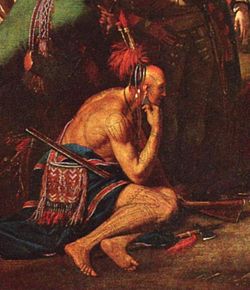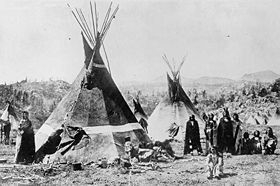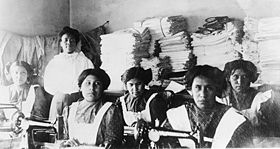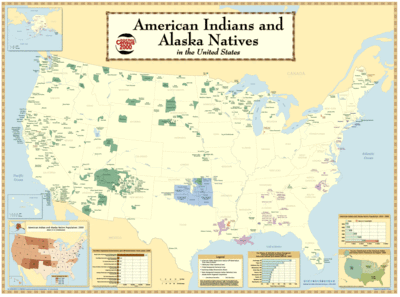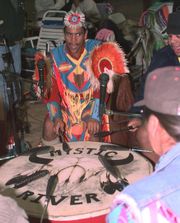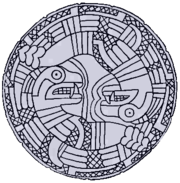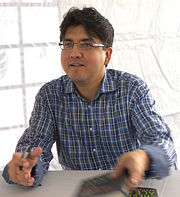Native Americans in the United States
2008/9 Schools Wikipedia Selection. Related subjects: Peoples
| Native Americans and Alaska Natives |
|---|
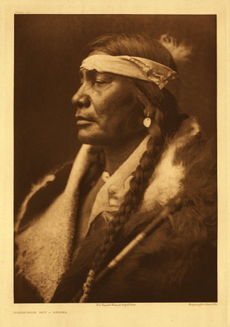 |
| Total population |
|
American Indian and Alaska Native |
| Regions with significant populations |
(predominantly the Midwest and West) |
| Languages |
| American English Native American languages |
| Religions |
| Native American Church Christianity Sacred Pipe Kiva Religion Long House |
| Related ethnic groups |
| Other Indigenous peoples of the Americas |
Native Americans in the United States are the indigenous peoples from the regions of North America now encompassed by the continental United States, including parts of Alaska. They comprise a large number of distinct tribes, states, and ethnic groups, many of which still endure as political communities. There is a wide range of terms used, and some controversy surrounding their use: they are variously known as American Indians, Indians, Amerindians, Amerinds, or Indigenous, Aboriginal or Original Americans.
Not all Native Americans come from the continental U.S. Some come from Alaska and other insular regions. These other indigenous peoples, including Alaskan Native groups such as the Inupiaq, Yupik Eskimos, and Aleuts, are not always counted as Native Americans, although Census 2000 demographics listed "American Indian and Alaskan Native" collectively. Native Hawaiians and various other Pacific Islander American peoples, such as the Chamorros (Chamoru), can also be considered Native American but it is not common to use such a designation.
European colonization
Initial impacts
The European colonization of the Americas nearly obliterated the populations and cultures of the Native Americans. During the 16th through 19th centuries, their populations were ravaged by conflicts with European explorers and colonists, disease, displacement, enslavement, internal warfare as well as high rate of intermarriage. Scholars now believe that, among the various contributing factors, epidemic disease was the overwhelming cause of the population decline of the American natives.
The first Native American group encountered by Christopher Columbus in 1492 were the Island Arawaks (more properly called the Taino) of Boriquen (Puerto Rico), the ( Quisqueya) of the Dominican Republic, the Cubanacan (Cuba). It is said that of the 250,000 to 1 million Island Arawaks, only about 500 survived by the middle of the 16th century, and the group was considered extinct by the middle of the 17th century. Yet DNA studies show that the genetic contribution of the Taino to that region continues, and the mitochondrial DNA studies of the Taino are said to show relationships to the Northern Indigenous Nations, such as Inuit and others.
In the sixteenth century, Spaniards and other Europeans brought horses to the Americas. Some of these animals escaped and began to breed and increase their numbers in the wild. Horses had previously migrated naturally to North America but the early American horse became game for the earliest humans and became extinct about 7,000 BC, just after the end of the last ice age. The re-introduction of the horse had a profound impact on Native American culture in the Great Plains of North America. As a new mode of travel the horse made it possible for some tribes to greatly expand their territories, exchange goods with neighboring tribes, and more easily capture game.
European settlers brought infectious diseases against which the Native Americans had no natural immunity. Chicken pox and measles, though common and rarely fatal among Europeans, often proved deadly to Native Americans. Smallpox proved particularly deadly to Native American populations. Epidemics often immediately followed European exploration, sometimes destroying entire villages. While precise figures are difficult to arrive at, some historians estimate that up to 80% of some Native populations died due to European diseases.
In 1617-1619, smallpox wiped out 90% of the Massachusetts Bay Native Americans. As it had done elsewhere, the virus wiped out entire population groups of Native Americans. It reached Mohawks in 1634, Lake Ontario in 1636, and the lands of the Iroquois by 1679. During the 1770s, smallpox killed at least 30% of the West Coast Native Americans. Smallpox epidemics in 1780-1782 and 1837-1838 brought devastation and drastic depopulation among the Plain Indians. By 1832, the federal government established a smallpox vaccination program for Native Americans (The Indian Vaccination Act of 1832).
American Revolution
During the American Revolution, the newly proclaimed United States competed with the British for the allegiance of Native American nations east of the Mississippi River. Most Native Americans who joined the struggle sided with the British, hoping to use the American Revolutionary War to halt further colonial expansion onto Native American land. Many native communities were divided over which side to support in the war. For the Iroquois Confederacy, the American Revolution resulted in civil war. Cherokees split into a neutral (or pro-American) faction and the anti-American Chickamaugas, led by Dragging Canoe.
Frontier warfare during the American Revolution was particularly brutal, and numerous atrocities were committed by settlers and native tribes. Noncombatants suffered greatly during the war, and villages and food supplies were frequently destroyed during military expeditions. The largest of these expeditions was the Sullivan Expedition of 1779, which destroyed more than 40 Iroquois villages in order to neutralize Iroquois raids in upstate New York. The expedition failed to have the desired effect: Native American activity became even more determined.
The British made peace with the Americans in the Treaty of Paris (1783), ceding vast Native American territories to the United States without informing the Native Americans. The United States initially treated the Native Americans who had fought with the British as a conquered people who had lost their land. When this proved impossible to enforce, the policy was abandoned. The United States was eager to expand, and the national government initially sought to do so only by purchasing Native American land in treaties. The states and settlers were frequently at odds with this policy.
Removal and reservations
In the nineteenth century, the incessant westward expansion of the United States incrementally compelled large numbers of Native Americans to resettle further west, often by force, almost always reluctantly. Under President Andrew Jackson, United States Congress passed the Indian Removal Act of 1830, which authorized the President to conduct treaties to exchange Native American land east of the Mississippi River for lands west of the river. As many as 100,000 Native Americans eventually relocated in the West as a result of this Indian Removal policy. In theory, relocation was supposed to be voluntary (and many Native Americans did remain in the East), but in practice great pressure was put on Native American leaders to sign removal treaties. Arguably the most egregious violation of the stated intention of the removal policy was the Treaty of New Echota, which was signed by a dissident faction of Cherokees but not the elected leadership. The treaty was brutally enforced by Jackson, which resulted in the deaths of an estimated four thousand Cherokees on the Trail of Tears.
The explicit policy of Indian Removal forced or coerced the relocation of major Native American groups in the Eastern United States, resulting directly and indirectly in the deaths of tens of thousands. The subsequent process of assimilations was no less devastating to Native American peoples. Tribes were generally located to reservations on which they could more easily be separated from traditional life and pushed into European-American society. Some southern states additionally enacted laws in the 19th century forbidding non-Indian settlement on Indian lands, intending to prevent sympathetic white missionaries from aiding the scattered Indian resistance.
At one point, President Jackson told people to kill as many American Bison as possible in order to cut out the Plains Indian's main source of food. At one point, there were fewer than 500 bison left in the Great Plains.
Conflicts, generally known as " Indian Wars", broke out between U.S. forces and many different tribes. U.S. government authorities entered numerous treaties during this period but later abrogated many for various reasons. Well-known military engagements include the Native American victory at the Battle of Little Bighorn in 1876 and the massacre of Native Americans at Wounded Knee in 1890. This, together with the near-extinction of the bison that many tribes had lived on, set about the downturn of Prairie Culture that had developed around the use of the horse for hunting, travel and trading.
American policy toward Native Americans has been an evolving process. In the late nineteenth century, reformers, in efforts to "civilize" or otherwise assimilate Indians (as opposed to relegating them to reservations), adapted the practice of educating native children in Indian Boarding Schools. These schools, which were primarily run by Christian missionaries, often proved traumatic to Native American children, who were forbidden to speak their native languages, taught Christianity instead of their native religions and in numerous other ways forced to abandon their various Native American identities and adopt European-American culture. There are also many documented cases of sexual, physical and mental abuses occurring at these schools.
The Indian Citizenship Act of 1924 gave United States citizenship to Native Americans, in part because of an interest by many to see them merged with the American mainstream, and also because of the service of many Native American veterans in World War I.
Current status
There are 561 federally recognized tribal governments in the United States. These tribes possess the right to form their own government, to enforce laws (both civil and criminal), to tax, to establish membership, to license and regulate activities, to zone and to exclude persons from tribal territories. Limitations on tribal powers of self-government include the same limitations applicable to states; for example, neither tribes nor states have the power to make war, engage in foreign relations, or coin money (this includes paper currency).
Many Native Americans and advocates of Native American rights point out that the US Federal government's claim to recognize the "sovereignty" of Native American peoples falls short, given that the US still wishes to govern Native American peoples and treats them as subject to US law. True respect for Native American sovereignty, according to such advocates, would require the United States federal government to deal with Native American peoples in the same manner as any other sovereign nation, handling matters related to relations with Native Americans through the Secretary of State, rather than the Bureau of Indian Affairs. The Bureau of Indian Affairs reports on its website that its "responsibility is the administration and management of 55,700,000 acres (225,000 km²) of land held in trust by the United States for American Indians, Indian tribes, and Alaska Natives." Many Native Americans and advocates of Native American rights believe that it is condescending for such lands to be considered "held in trust" and regulated in any fashion by a foreign power, whether the US Federal Government, Canada, or any other non-Native American authority.
According to 2003 United States Census Bureau estimates, a little over one third of the 2,786,652 Native Americans in the United States live in three states: California at 413,382, Arizona at 294,137 and Oklahoma at 279,559.
As of 2000, the largest tribes in the U.S. by population were Navajo, Cherokee, Choctaw, Sioux, Chippewa, Apache, Lumbee, Blackfeet, Iroquois, and Pueblo. In 2000, eight of ten Americans with Native American ancestry were of mixed blood. It is estimated that by 2100 that figure will rise to nine out of ten. In addition, there are a number of tribes that are recognized by individual states, but not by the federal government. The rights and benefits associated with state recognition vary from state to state.
Some tribal nations have been unable to establish their heritage and obtain federal recognition. The Muwekma Ohlone of the San Francisco bay area are pursuing litigation in the federal court system to establish recognition. Many of the smaller eastern tribes have been trying to gain official recognition of their tribal status. The recognition confers some benefits, including the right to label arts and crafts as Native American and permission to apply for grants that are specifically reserved for Native Americans. But gaining recognition as a tribe is extremely difficult; to be established as a tribal group, members have to submit extensive genealogical proof of tribal descent.
Military defeat, cultural pressure, confinement on reservations, forced cultural assimilation, outlawing of native languages and culture, termination policies of the 1950s and 1960s and earlier, slavery, and poverty have had deleterious effects on Native Americans' mental and physical health. Contemporary health problems suffered disproportionately include alcoholism, heart disease, diabetes, and suicide.
As recently as the 1970s, the Bureau of Indian Affairs was still actively pursuing a policy of "assimilation", dating at least to the Indian Citizenship Act of 1924. The goal of assimilation — plainly stated early on — was to eliminate the reservations and steer Native Americans into mainstream U.S. culture. In July 2000 the Washington state Republican Party adopted a resolution of termination for tribal governments. As of 2004, there are still claims of theft of Native American land for the coal and uranium it contains.
In the state of Virginia, Native Americans face a unique problem. Virginia has no federally recognized tribes, largely due to Walter Ashby Plecker. In 1912, Plecker became the first registrar of the state's Bureau of Vital Statistics, serving until 1946. Plecker believed that the state's Native Americans had been "mongrelized" with its African American population. A law passed by the state's General Assembly recognized only two races, "white" and "colored". Plecker pressured local governments into reclassifying all Native Americans in the state as "colored", leading to the destruction of records on the state's Native American community.
Maryland also has a non-recognized tribal nation — the Piscataway Indian Nation.
In order to receive federal recognition and the benefits it confers, tribes must prove their continuous existence since 1900. The federal government has so far refused to bend on this bureaucratic requirement. A bill currently before U.S. Congress to ease this requirement has been favorably reported out of a key Senate committee, being supported by both of Virginia's senators, George Allen and John Warner, but faces opposition in the House from Representative Virgil Goode, who has expressed concerns that federal recognition could open the door to gambling in the state.
In the early 21st century, Native American communities remain an enduring fixture on the United States landscape, in the American economy, and in the lives of Native Americans. Communities have consistently formed governments that administer services like firefighting, natural resource management, and law enforcement. Most Native American communities have established court systems to adjudicate matters related to local ordinances, and most also look to various forms of moral and social authority vested in traditional affiliations within the community. To address the housing needs of Native Americans, Congress passed the Native American Housing and Self Determination Act (NAHASDA) in 1996. This legislation replaced public housing, and other 1937 Housing Act programs directed towards Indian Housing Authorities, with a block grant program directed towards Tribes.
Gambling has become a leading industry. Casinos operated by many Native American governments in the United States are creating a stream of gambling revenue that some communities are beginning to use as leverage to build diversified economies. Native American communities have waged and prevailed in legal battles to assure recognition of rights to self-determination and to use of natural resources. Some of those rights, known as treaty rights, are enumerated in early treaties signed with the young United States government. Tribal sovereignty has become a cornerstone of American jurisprudence, and at least on the surface, in national legislative policies. Although many Native American tribes have casinos, they are a source of conflict. Most tribes, especially small ones such as the Winnemem Wintu of Redding, California, feel that casinos and their proceeds destroy culture from the inside out. These tribes refuse to participate in the gaming industry.
On May 19, 2005, the Massachusetts legislature finally repealed a disused 330 year-old law that barred Native Americans from entering Boston.
In August 2005, the National Collegiate Athletic Association (NCAA) banned the use of "hostile and abusive" Native American mascots from postseason tournaments. The use of Native American themed team names in U.S. professional sports is widespread and often controversial, with examples such as Chief Wahoo of the Cleveland Indians and the Washington Redskins.
Conflicts between the federal government and native Americans occasionally erupt into violence. Perhaps one of the more noteworthy incidents in recent history is the Wounded Knee incident in small town of Wounded Knee, South Dakota. On February 27, 1973, the town was surrounded by federal law enforcement officials and the United States military. The town itself was under the control of members of the American Indian Movement which was protesting a variety of issues important to the organization. Two members of AIM were killed and one United States Marshal was paralyzed as a result of gunshot wounds. In the aftermath of the conflict, one man, Leonard Peltier was arrested and sentenced to life in prison while another, John Graham, as late as 2007, was extradited to the U.S. to stand trial for killing a Native American woman, months after the standoff, that he believed to be an FBI informant.
Despite the ongoing political and social issues surrounding Native Americans' position in the United States, there has been relatively little public opinion research on attitudes toward them among the general public. In a 2007 focus group study by the nonpartisan Public Agenda organization, most non-Indians admitted they rarely encounter Native Americans in their daily lives. While sympathetic toward Native Americans and expressing regret over the past, most people had only a vague understanding of the problems facing Native Americans today. For their part, Native Americans told researchers that they believed they continued to face prejudice and mistreatment in the broader society.
Blood Quanta
Intertribal and interracial mixing was common among Native American tribes making it difficult to clearly identify which tribe an individual belonged to. Bands or entire tribes occasionally split or merged to form more viable groups in reaction to the pressures of climate, disease and warfare. A number of tribes practiced the adoption of captives into their group to replace their members who had been captured or killed in battle. These captives came from rival tribes and later from European settlers. Some tribes also sheltered or adopted white traders and runaway slaves and Native American-owned slaves. So a number of paths to genetic mixing existed.
In later years, such mixing, however, proved an obstacle to qualifying for recognition and assistance from the U.S. federal government or for tribal money and services. To receive such support, Native Americans must belong to and be certified by a recognized tribal entity. This has taken a number of different forms as each tribal government makes its own rules while the federal government has its own set of standards. In many cases, qualification is based upon the percentage of Native American blood, or the "blood quanta" identified in an individual seeking recognition. To attain such certainty, some tribes have begun requiring genetic genealogy (DNA testing). Requirements for tribal certification vary widely. The Cherokee require only a descent from an Native American listed on the early 20th century Dawes Rolls while federal scholarships require enrollment in a federally recognized tribe as well as a Certificate of Degree of Indian Blood card showing at least a one-quarter Native American descent. Tribal rules regarding recognition of members with Native American blood from multiple tribes are equally diverse and complex.
Tribal membership conflicts have led to a number of activist groups, legal disputes and court cases. One example are the Cherokee freedmen, who were descendants of slaves once owned by the Cherokees. The Cherokees had allied with the Confederate States of America in the American Civil War and, after the war, were forced by the federal government, in an 1866 treaty, to free their slaves and make them citizens. They were later disallowed as tribe members due to their not having "Indian blood". However, in March 2006, the Judicial Appeals Tribunal — the Cherokee Nation's highest court — ruled that Cherokee freedmen are full citizens of the Cherokee Nation. The court declared that the Cherokee freedmen retain citizenship, voting rights and other privileges despite attempts to keep them off the tribal rolls for not having identifiable "Indian" blood. In March 2007 the Freedmen were voted out of the Cherokee Nation of Oklahoma.
In the 20th century, among white ethnic groups, it became popular to claim descent from an "American Indian princess", often a Cherokee. The prototypical "American Indian princess" was Pocahontas, and, in fact, descent from her is a frequent claim. However, the American Indian "princess" is a false concept, derived from the application of European concepts to Native Americans, as also seen in the naming of war chiefs as "kings". Descent from "Indian braves" is also sometimes claimed.
This descent from Native Americans was seen as fashionable not only among whites claiming prestigious colonial descent but also among whites seeking to claim connection to groups with distinct folkways that would differentiate them from the mass culture. Large influxes of recent immigrants with unique social customs may have been partially an object of envy. Among African-Americans, the desire to be un-black was sometimes expressed in claims of Native American descent. Those passing as white might use the slightly more acceptable Native American ancestry to explain inconvenient details of their heritage.
Cultural aspects
Though cultural features, language, clothing, and customs vary enormously from one tribe to another, there are certain elements which are encountered frequently and shared by many tribes.
Early hunter-gatherer tribes made stone weapons from around 10,000 years ago; as the age of metallurgy dawned, newer technologies were used and more efficient weapons produced. Prior to contact with Europeans, most tribes used similar weaponry. The most common implement were the bow and arrow, the war club, and the spear. Quality, material, and design varied widely.
Large mammals like mammoths and mastodons were largely extinct by around 8,000 B.C., and the Native Americans switched to hunting other large game, such as bison. The Great Plains tribes were still hunting the bison when they first encountered the Europeans. The acquisition of the horse and horsemanship from the Spanish in the 17th century greatly altered the natives' culture, changing the way in which these large creatures were hunted and making them a central feature of their lives.
Organization
Gens structure
Before the formation of tribal structure, a structure dominated by gentes existed.
- The right of electing its sachem and chiefs.
- The right of deposing its sachem and chiefs.
- The obligation not to marry in the gens.
- Mutual rights of inheritance of the property of deceased members.
- Reciprocal obligations of help, defense, and redress of injuries.
- The right of bestowing names upon its members.
- The right of adopting strangers into the gens.
- Common religious rights, query.
- A common burial place.
- A council of the gens.
Tribal structure
Subdivision and differentiation took place between various groups. Upwards of forty stock languages developed in North America, with each independent tribe speaking a dialect of one of those languages. Some functions and attributes of tribes are:
- The possession of a territory and a name.
- The exclusive possession of a dialect.
- The right to invest sachems and chiefs elected by the gentes.
- The right to depose these sachems and chiefs.
- The possession of a religious faith and worship.
- A supreme government consisting of a council of chiefs.
- A head-chief of the tribe in some instances.
Society and art
The Iroquois, living around the Great Lakes and extending east and north, used strings or belts called wampum that served a dual function: the knots and beaded designs mnemonically chronicled tribal stories and legends, and further served as a medium of exchange and a unit of measure. The keepers of the articles were seen as tribal dignitaries.
Pueblo peoples crafted impressive items associated with their religious ceremonies. Kachina dancers wore elaborately painted and decorated masks as they ritually impersonated various ancestral spirits. Sculpture was not highly developed, but carved stone and wood fetishes were made for religious use. Superior weaving, embroidered decorations, and rich dyes characterized the textile arts. Both turquoise and shell jewelry were created, as were high-quality pottery and formalized pictorial arts.
Navajo spirituality focused on the maintenance of a harmonious relationship with the spirit world, often achieved by ceremonial acts, usually incorporating sandpainting. The colors—made from sand, charcoal, cornmeal, and pollen—depicted specific spirits. These vivid, intricate, and colorful sand creations were erased at the end of the ceremony.
Religion
The most widespread religion at the present time is known as the Native American Church. It is a syncretistic church incorporating elements of native spiritual practice from a number of different tribes as well as symbolic elements from Christianity. Its main rite is the peyote ceremony. Prior to 1890, traditional religious beliefs included Wakan Tanka. In the American Southwest, especially New Mexico, a syncretism between the Catholicism brought by Spanish missionaries and the native religion is common; the religious drums, chants, and dances of the Pueblo people are regularly part of Masses at Santa Fe's Saint Francis Cathedral. Native American-Catholic syncretism is also found elsewhere in the United States. (e.g., the National Kateri Tekakwitha Shrine in Fonda, New York and the National Shrine of the North American Martyrs in Auriesville, New York).
Native Americans are the only known ethnic group in the United States requiring a federal permit to practice their religion. The eagle feather law, (Title 50 Part 22 of the Code of Federal Regulations), stipulates that only individuals of certifiable Native American ancestry enrolled in a federally recognized tribe are legally authorized to obtain eagle feathers for religious or spiritual use. Native Americans and non-Native Americans frequently contest the value and validity of the eagle feather law, charging that the law is laden with discriminatory racial preferences and infringes on tribal sovereignty. The law does not allow Native Americans to give eagle feathers to non-Native Americans, a common modern and traditional practice. Many non-Native Americans have been adopted into Native American families, made tribal members and given eagle feathers.
Many Native Americans would describe their religious practices as a form of spirituality, rather than religion, although in practice the terms may sometimes be used interchangeably.
Native Americans and African Americans
There were historical treaties between the European Colonists and the Native American tribes requesting the return of any runaway slaves. For example, in 1726, the British Governor of New York exacted a promise from the Iroquois to return all runaway slaves who had joined up with them. This same promise was extracted from the Huron Natives in 1764 and from the Delaware Natives in 1765. There are also numerous accounts of advertisements requesting the return of African Americans who had married Native Americans or who spoke a Native American language. Individuals in some tribes owned African slaves; however, other tribes incorporated African Americans, slave or freemen, into the tribe. This custom among the Seminoles was part of the reason for the Seminole Wars where the European Americans feared their slaves fleeing to the Natives. The Cherokee Freedmen and tribes such as the Lumbee in North Carolina include African American ancestors.
After 1800, the Cherokees and some other tribes started buying and using black slaves, a practice they continued after being relocated to Indian Territory in the 1830s. The nature of slavery in Cherokee society often mirrored that of white slave-owning society. The law barred intermarriage of Cherokees and blacks, whether slave or free. Blacks who aided slaves were punished with one hundred lashes on the back. In Cherokee society, blacks were barred from holding office, bearing arms, and owning property, and it was illegal to teach blacks to read and write.
Gender roles
Most Native American tribes had traditional gender roles. In some tribes, such as the Iroquois nation, social and clan relationships were matrilinear and/or matriarchal, although several different systems were in use. One example is the Cherokee custom of wives owning the family property. Men hunted, traded and made war, while women cared for the young and the elderly, fashioned clothing and instruments and cured meat. The cradle board was used by mothers to carry their baby while working or traveling. However, in some (but not all) tribes a kind of transgender was permitted; see Two-Spirit.
At least several dozen tribes allowed polygyny to sisters, with procedural and economic limits.
Apart from making home, women had many tasks that were essential for the survival of the tribes. They made weapons and tools, took care of the roofs of their homes and often helped their men hunt buffalos. In some of the Plains Indian tribes there reportedly were medicine women who gathered herbs and cured the ill.
In some of these tribes girls were also encouraged to learn to ride and fight. Though fighting was mostly left to the boys and men, there had been cases of women fighting alongside them, especially when the existence of the tribe was threatened.
Music and art
Native American music is almost entirely monophonic, but there are notable exceptions. Traditional Native American music often includes drumming and/or the playing of rattles or other percussion instruments but little other instrumentation. Flutes and whistles made of wood, cane, or bone are also played, generally by individuals, but in former times also by large ensembles (as noted by Spanish conquistador de Soto). The tuning of these flutes is not precise and depends on the length of the wood used and the hand span of the intended player, but the finger holes are most often around a whole step apart and, at least in Northern California, a flute was not used if it turned out to have an interval close to a half step.
Performers with Native American parentage have occasionally appeared in American popular music, such as Tina Turner, Rita Coolidge, Wayne Newton, Gene Clark, Tori Amos and Redbone (band). Some, such as John Trudell have used music to comment on life in Native America, and others, such as R. Carlos Nakai integrate traditional sounds with modern sounds in instrumental recordings. A variety of small and medium-sized recording companies offer an abundance of recent music by Native American performers young and old, ranging from pow-wow drum music to hard-driving rock-and-roll and rap.
The most widely practiced public musical form among Native Americans in the United States is that of the pow-wow. At pow-wows, such as the annual Gathering of Nations in Albuquerque, New Mexico, members of drum groups sit in a circle around a large drum. Drum groups play in unison while they sing in a native language and dancers in colorful regalia dance clockwise around the drum groups in the center. Familiar pow-wow songs include honour songs, intertribal songs, crow-hops, sneak-up songs, grass-dances, two-steps, welcome songs, going-home songs, and war songs. Most indigenous communities in the United States also maintain traditional songs and ceremonies, some of which are shared and practiced exclusively within the community.
Native American art comprises a major category in the world art collection. Native American contributions include pottery, paintings, jewelry, weavings, sculptures, basketry, and carvings.
Artists have at times misrepresented themselves as having native parentage, most notably Johnny Cash, who traced his heritage to Scottish ancestors and admitted he fabricated a story that he was one-quarter Cherokee. The integrity of certain Native American artworks is now protected by an act of Congress that prohibits representation of art as Native American when it is not the product of an enrolled Native American artist.
Traditional economy
The Inuit, or Eskimo, prepared and buried large amounts of dried meat and fish. Pacific Northwest tribes crafted seafaring dugouts 40–50 feet long for fishing. Farmers in the Eastern Woodlands tended fields of maize with hoes and digging sticks, while their neighbors in the Southeast grew tobacco as well as food crops. On the Plains, some tribes engaged in agriculture but also planned buffalo hunts in which herds were efficiently driven over bluffs. Dwellers of the Southwest deserts hunted small animals and gathered acorns to grind into flour with which they baked wafer-thin bread on top of heated stones. Some groups on the region's mesas developed irrigation techniques, and filled storehouses with grain as protection against the area's frequent droughts.
As these native peoples encountered European explorers and settlers and engaged in trade, they exchanged food, crafts, and furs for trinkets, blankets, iron, and steel implements, horses, firearms, and alcoholic beverage
Depictions by Europeans and Americans
Native Americans have been depicted by American artists in various ways at different historical periods. During the period when America was first being colonized, in the fifteenth and sixteenth centuries, the artist John White made watercolors and engravings of the people native to the southeastern states. John White’s images were, for the most part, faithful likenesses of the people he observed. Later the artist Theodore de Bry used White’s original watercolors to make a book of engravings entitled, A briefe and true report of the new found land of Virginia. In his book, de Bry often altered the poses and features of White’s figures to make them appear more European, probably in order to make his book more marketable to a European audience. During the period that White and de Bry were working, when Europeans were first coming into contact with native Americans, there was a large interest and curiosity in native American cultures by Europeans, which would have created the demand for a book like de Bry’s.
Several centuries later, during the construction of the Capitol building in the early nineteenth century, the U.S. government commissioned a series of four relief panels to crown the doorway of the Rotunda. The reliefs encapsulate a vision of European--Native American relations that had assumed mythicohistorical proportions by the nineteenth century. The four panels depict: The Preservation of Captain Smith by Pocahontas (1825) by Antonio Capellano, The Landing of the Pilgrims (1825) and The Conflict of Daniel Boone and the Indians (1826-27) by Enrico Causici, and William Penn’s Treaty with the Indians (1827) by Nicholas Gevelot. The reliefs present idealized versions of the Europeans and the native Americans, in which the Europeans appear refined and gentile, and the natives appear ferocious and savage. The Whig representative of Virginia, Henry A. Wise, voiced a particularly astute summary of how Native Americans would read the messages contained in all four reliefs: “We give you corn, you cheat us of our lands: we save your life, you take ours.”
While many nineteenth century images of native Americans conveyed similarly negative messages, there were artists, such as Charles Bird King, who sought to express a more positive image of the native Americans as noble savages.
Terminology differences
It is a common mistake to believe when Christopher Columbus arrived in the " New World", he described the people he encountered as Indians because he believed that he had reached the Indies, the original destination of his voyage. This is false. The term "Indian" comes from Christopher Columbus, but it wasn't because he thought he reached India. The region of the Indian subcontinent where India now lies was referred to as Hindustan. Christopher Columbus called the Native Americans "Indians" because in the language Columbus spoke (Genoese Italian & crude Spanish/Portuguese), "In Deos" meant "From God". Columbus saw the Native Americans as beautiful creatures delivered to Earth from God.
Common usage in the United States
The term Native American was originally introduced in the United States by anthropologists as a more accurate term for the indigenous people of the Americas, as distinguished from the people of India. Because of the widespread acceptance of this newer term in and outside of academic circles, some people believe that Indians is outdated or offensive. People from India (and their descendants) who are citizens of the United States are known as Indian Americans.
Criticism of the neologism Native American, however, comes from diverse sources. Some American Indians have misgivings about the term Native American. Russell Means, a famous American Indian activist, opposes the term Native American because he believes it was imposed by the government without the consent of American Indians. Furthermore, some American Indians question the term Native American because, they argue, it serves to ease the conscience of "white America" with regard to past injustices done to American Indians by effectively eliminating "Indians" from the present. Still others (both Indians and non-Indians) argue that Native American is problematic because "native of" literally means "born in," so any person born in the Americas could be considered "native". However, very often the compound "Native American" will be capitalized in order to differentiate this intended meaning from others. Likewise, "native" (small 'n') can be further qualified by formulations such as "native-born" when the intended meaning is only to indicate place of birth or origin.
A 1996 survey revealed that more American Indians in the United States still preferred American Indian to Native American. Nonetheless, most American Indians are comfortable with Indian, American Indian, and Native American, and the terms are now used interchangeably. The continued usage of the traditional term is reflected in the name chosen for the National Museum of the American Indian, which opened in 2004 in Washington, D.C..
Recently, the U.S. Census introduced the "Asian Indian" category to more accurately sample the Indian American population.
State percentages
As of 2005 Census estimates, 1.0 percent of the US population is of American Indian and Alaska Native descent. This population is unevenly distributed across the country, with Alaska and New Mexico boasting double digit native populations while in five states they constitute only 0.2% of the population.
- Alaska 16%
- New Mexico 10.2%
- South Dakota 8.8%
- Oklahoma 8.1%
- Montana 6.5%
- North Dakota 5.3%
- Arizona 5.1%
- Wyoming 2.7%
- Washington 1.7%
- Idaho 1.4%
- Nevada 1.4%
- Oregon 1.4%
- Utah 1.3%
- North Carolina 1.3%
- Minnesota 1.2%
- California 1.2%
- Colorado 1.1%
- Wisconsin 0.9%
- Kansas 0.9%
- Nebraska 0.9%
- Texas 0.7%
- Arkansas 0.7%
- Maine 0.6%
- Rhode Island 0.6%
- Michigan 0.6%
- Louisiana 0.6%
- New York 0.5%
- Alabama 0.5%
- Vermont 0.4%
- South Carolina 0.4%
- Missouri 0.4%
- Mississippi 0.4%
- Delaware 0.4%
- Florida 0.4%
- Virginia 0.3%
- District of Columbia 0.3%
- Connecticut 0.3%
- New Jersey 0.3%
- Maryland 0.3%
- Iowa 0.3%
- Massachusetts 0.3%
- Indiana 0.3%
- Tennessee 0.3%
- Illinois 0.3%
- Hawaii 0.3% Native Hawaiian 9%
- Georgia 0.3%
- Kentucky 0.2%
- New Hampshire 0.2%
- Ohio 0.2%
- Pennsylvania 0.2%
- West Virginia 0.2%
- New Mexico 10.2%
